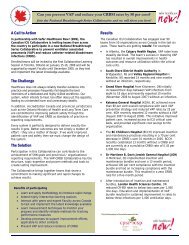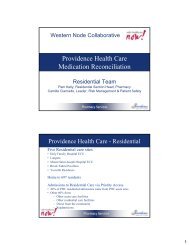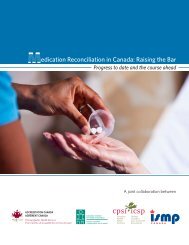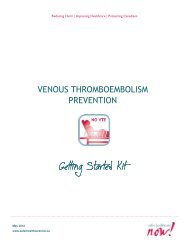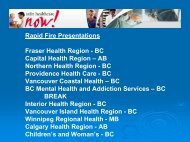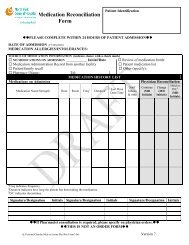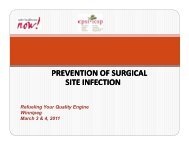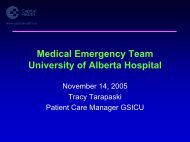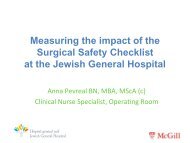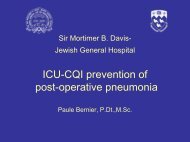VAP Getting Started Kit - Safer Healthcare Now!
VAP Getting Started Kit - Safer Healthcare Now!
VAP Getting Started Kit - Safer Healthcare Now!
Create successful ePaper yourself
Turn your PDF publications into a flip-book with our unique Google optimized e-Paper software.
<strong>Safer</strong> <strong>Healthcare</strong> <strong>Now</strong>! Prevent Ventilator Associated Pneumonia <strong>Getting</strong> <strong>Started</strong> <strong>Kit</strong><br />
What improvements can we do to minimize the risk of aspiration or pneumonia when<br />
administering enteral nutrition?<br />
• Oral vs. nasal? When possible large bore feeding tubes should be placed orally while it is<br />
acceptable to place small bore feeding tubes nasally.<br />
• Obtain confirmation of correct placement of a newly blindly-inserted tube before<br />
initiating feeding or administering medication. Place a mark on the exit site of the<br />
feeding tube and monitor patient for tube dislodgement and reconfirm placement if in<br />
doubt. 132 We strongly recommend that medical order authorizing initiation of enteral<br />
nutrition include a statement about the anatomical location of the tip of the tube. This<br />
is best achieved by the use of pre-printed orders (see ex JGH). Readers are invited to<br />
read the Enteral Nutrition Practice Guidelines for further discussion on techniques for<br />
insertion and monitoring of feeding tubes.<br />
• Position patients correctly all the time. Elevation of the head of the bed (HOB) to 45 0<br />
(and if not possible, attempts to keep > 30 0 ) should be considered as an integral part of<br />
the <strong>VAP</strong> bundle. Moreover, there is a consensus that critically ill patients receiving<br />
enteral nutrition have the head of the bed elevated to 45°. When this is not possible,<br />
attempts to raise the head of the bed at least > 30° should be considered. Where this is<br />
not possible, attempts to raise the head of the bed as much as possible should be<br />
considered. 128,130,131,132 Among the recognized contraindications to a semi-recumbent<br />
position are an unstable spine, hemodynamic instability, prone positioning, and certain<br />
medical procedures (such as a central venous catheter insertion). The reverse<br />
Trendelenberg position to elevate the HOB, unless contraindicated, when the patient<br />
cannot tolerate a backrest elevated position should be used. The position should be<br />
returned to 45° as soon as possible after a procedure. When this is not possible,<br />
attempts to raise the head of the bed at least > 30° should be considered. To increase<br />
compliance use written (pre-printed orders).<br />
• Understand the limitations of Gastric residuals. Measurement of gastric residual<br />
volumes (GRV) to monitor tolerance to enteral nutrition is controversial and there is<br />
confusion as to its impact on clinical outcome as it does not reflect the pathophysiology<br />
of critical illness and is influenced by numerous factors including the type of tube, the<br />
syringe, the position of the patient etc“ the elevated residual volumes by themselves<br />
have little clinical meaning and that only when combined with vomiting, sepsis, sedation,<br />
or the need for pressor agents does the correlation with worsening patient outcome<br />
emerge.” 134 Nevertheless it is recommended to measure gastric residuals every 4 hours in<br />
critically ill patients. 132 Gastric residual volumes in the range of 200-500 mL should raise<br />
concern and lead to the implementation of measures to reduce risk of aspiration, but<br />
automatic cessation of feeding should not occur for gastric residual volumes 500 mL should result in holding EN<br />
and reassessing patient tolerance by use of an established algorithm including physical<br />
assessment, GI assessment, evaluation of glycemic control, minimization of sedation, and<br />
consideration of promotility agent use, if not already prescribed. 132<br />
June 2012 26



